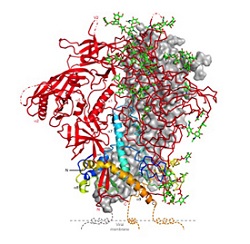 |
| Structure of the HIV spike protein in its closed state, which makes it less detectable to the immune system--Courtesy of Peter Kwong |
New technology has allowed researchers to view HIV proteins in action, zooming in on so-called spikes that help the virus bind to cells it infects.
The research puts scientists one step closer to a vaccine that could effectively prevent transmission of HIV and halt the spread of AIDS, an international epidemic.
One popular HIV vaccine theory has attempted to solve the mystery of how a small set of patients' immune systems were able to generate rare antibodies that thwarted most strains of the virus. The new research explains how this class of antibodies many be able to offer protection against the disease.
Using a powerful imaging technique called single-molecule fluorescence resonance energy transfer (smFRET) imaging, researchers from the National Institutes of Health, Weill Cornell Medical College and Yale University School of Medicine observed the motions of a key proteins on the surface of HIV called spike proteins.
Each spike is made up of three sets of a pair of molecules. Before the spike binds to a host immune cell as well as during this process, researchers found that the spike alters its shape, rapidly shifting among three different configurations.
The spike protein needs to be in its "open" state to attach to cells and infect them. However, in a closed state, which is the spike's predominant form, it is less visible to antibodies.
The researchers conclude that an effective HIV vaccine would allow the spike protein to stay longer in the closed state and only briefly open. This would allow antibiodies to find the spike then quickly cut it off from causing infection.
The investigators speculate that in the few patients that were able to ward off the virus, the broadly neutralizing antibodies in their immune systems kept this spike protein closed, thereby preventing the spread of the virus.
The findings are detailed in two separate papers, one in Nature and the other in Science.
- get more from Weill Cornell Medical College
- see the study abstract in Science and the abstract in Nature